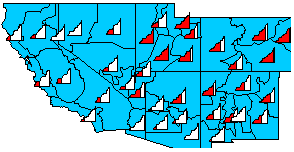
A thematic map is a way to represent the geographic distribution of data visually. A thematic map shows what data value is associated with a particular map location. The data can be represented for curves, areas, or point locations. Areas, curves, and points are referred to as boundary objects. A common thematic map example is a population map. Relative population could be represented by gradational colors such as blue to red, where blue represents the lowest population and red represents the highest population. This makes it easy to evaluate the population distribution quickly.
MapViewer thematic maps can associate data with areas (also called polygons), curves (polylines), or points on a map. MapViewer uses a primary ID to associate data with an area, curve, or point on the map (see Linking Data to Boundaries for more information). Each area, curve, or point on the map can have an associated primary ID, and this primary ID can also be found in the data file linked to the map.
Once you have determined the type of data you want to represent on the map, you need to decide how to show that data. There are many ways to represent data on a thematic map. Data can be represented by color, patterns, scaled symbols, scaled lines, scaled circles, dot densities, prism height, pie charts, bar charts, filled line graphs or by simply posting the data value at the location. For more information, see Map Types.
In addition, you can represent two or more map types at one time by using layers. Each layer in MapViewer can only contain a single map type.However, by creating two or more layers, you can easily display two or more types of data on a map.

Line graph maps are an easy way to display the
distribution of your data. By looking at an
individual line graph, you can see how an object's
data value relates to the entire data set.
See Also
Linking Data to Boundaries - The Primary ID